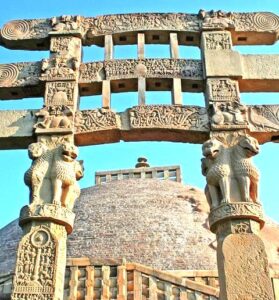
Located about 46km away from Bhopal, the town of Sanchi is an ensemble of Buddhist monuments. Sanchi, variously known as Kakanaya, Kakanava, Kakanadabota and Bota-Sriparvata in ancient times, has a singular distinction of having remarkable specimen of Buddhist art and architecture right from the early Mauryan period (c. third century BC to twelfth century AD). Sanchi is famous in the world for stupas, monolithic Asokan pillar, temples, monasteries and sculptural wealth. The Sanchi stupas are noteworthy for their gateways as they contain ornamented depiction of incidents from the life of Buddha and his previous incarnations, “Bodhisattvas”, as described in the Jataka tales. Here, Gautam Buddha is depicted by symbols, such as the wheel, which represents his teaching.
When it was discovered in 1818 by General Taylor, Sanchi had lain abandoned for 600 years. The site, located 45 km from Bhopal, was overrun with vegetation. Excavations began in somewhat disorganized fashion until the Archaeological Survey of India stepped in and took control. Gradually, as the hill was cleared, the ruins of about 50 monuments were uncovered, revealing one of the most remarkable archaeological complexes in India.
It would appear that the site was settled in the 3rd century B.C. at the time that the emperor Asoka, the grandson of Chandragupta, who had defeated the Macedonian invaders and founded the Maurya dynasty, was converted to Buddhism (c. 250). Asoka, whose queen was from the neighbouring town of Vidisha, founded, or at least embellished, a Buddhist sanctuary located at Sanchi. He also had a stone column more than 12 m high erected with his edicts carved on it. To the south of Asoka’s column and predating it is an early brick stupa. It is of about 20 m in diameter and is crowned with stone aedicula; a wooden railing encircles it.
Presently known as Stupa 1, this monument was enlarged under the Sunga and the Andhra dynasties (2nd and 1st centuries B.C.) and is the principal monument at Sanchi. It consists of a gigantic mound of sandstone surrounded by sumptuous porticoes with stone railings; its hemispherical dome measures 36.6 m in diameter and is 16.46 m high. It is particularly famous for the extraordinarily rich decorative work on the four monumental gateways or torana that provide access.
Positioned almost exactly in line with the four cardinal points, these gateways transpose into stone the structure of the wooden gateways : two pillars and three architraves reproduce the assembly of two posts joined by three rails. The lush carvings, prodigious creations in bas relief, high relief and in the round, are an iconographic treasure trove. The essential theme represented in the decorative work revolves around the former lives (jakata) of Buddha. Numerous other themes were taken from legends and history. The fresh, wonderfully charming representations of plants, animals and humans, the narrative quality of the stories and the creativity apparent in the fantastic sculptured capitals and cornices combine to to make this an unrivaled masterpiece of “early Buddhist art”.
Sanchi has two other famous stupas dating from the Sunga period (2nd century B.C.). The torana of Stupa 3, executed in the 1st century are exceptional works. Many other structures are found on the site : within the ruins of a wall dating from the llth-12th centuries, Sanchi’s final years are monolithic pillars, palaces, temples and monasteries, all in varying states of preservation. Temples 17 and 45 and monastery 51 are among the most impressive structures.
Criterion (i): The perfection of its proportions and the richness of the sculptured decorative work on its four gateways make Stupa 1 an incomparable artistic achievement. The group of Buddhist monuments at Sanchi -stupas, temples and monasteries-is unique in India because of its age and quality.
Criterion (ii): From the time that the oldest preserved monument on the site was erected, i.e. Asoka’s column with its projecting capital of lions inspired by Achaemenid art, Sanchi’s role as intermediary for the spread of cultures and their peripheral arts throughout the Maurya empire, and later in India of the Sunga, Shatavahana, Kushan and Gupta dynasties, was confirmed.
Criterion (iii): Having remained a principal center of Buddhism in medieval India following the spread of Hinduism, Sanchi bears unique witness as a major Buddhist sanctuary to the period from the 3rd century B.C. to the 1st century A.D.
Criterion (iv): The stupas at Sanchi, in particular Stupa 1 and Stupa 3, represent the most accomplished form of this type of monument. The hemispherical, egg-shapped dome (anda), topped with a cubical relic chamber (harmika), is built on a circular terrace (medhi); it has one or two ambulatories for the faithful to use (pradakshina patha). Representing a transposition from wood structures to stone, the railings (vedika) and the gateways (torana) also bear witness to the continued use of the primitive forms of megalithic tumuli covered with an outer layer and surrounded by a palisade.
Criterion (vi): Sanchi is the oldest extant Buddhist sanctuary. Although Buddha never visited the site during any of his former lives nor during his earthly existence, the religious nature of this shrine is obvious. The chamber of relics of Stupa 3 contained the remains of Shariputra, a disciple of Shakyamuni who died six months before his master; he is especially venerated by the occupants of the “small vehicle” or Hinayana.
Source:
http://asi.nic.in/asi_monu_whs_sanchi.asp
http://whc.unesco.org/en/list/524/documents/
http://knowindia.gov.in/culture-and-heritage/monuments/buddhist-monuments-at-sanchi.php


